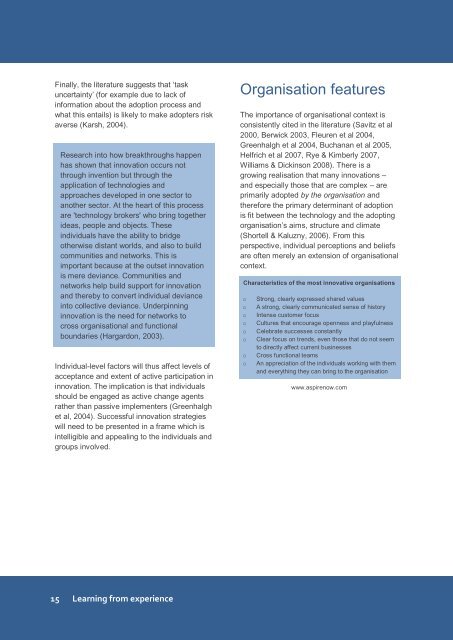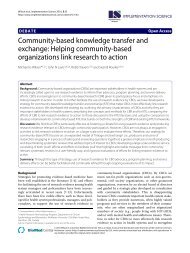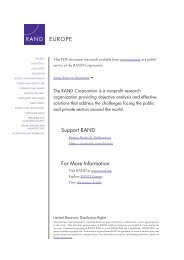Promoting and Embedding Innovation
Promoting and Embedding Innovation
Promoting and Embedding Innovation
Create successful ePaper yourself
Turn your PDF publications into a flip-book with our unique Google optimized e-Paper software.
Finally, the literature suggests that „task<br />
uncertainty‟ (for example due to lack of<br />
information about the adoption process <strong>and</strong><br />
what this entails) is likely to make adopters risk<br />
averse (Karsh, 2004).<br />
Research into how breakthroughs happen<br />
has shown that innovation occurs not<br />
through invention but through the<br />
application of technologies <strong>and</strong><br />
approaches developed in one sector to<br />
another sector. At the heart of this process<br />
are 'technology brokers' who bring together<br />
ideas, people <strong>and</strong> objects. These<br />
individuals have the ability to bridge<br />
otherwise distant worlds, <strong>and</strong> also to build<br />
communities <strong>and</strong> networks. This is<br />
important because at the outset innovation<br />
is mere deviance. Communities <strong>and</strong><br />
networks help build support for innovation<br />
<strong>and</strong> thereby to convert individual deviance<br />
into collective deviance. Underpinning<br />
innovation is the need for networks to<br />
cross organisational <strong>and</strong> functional<br />
boundaries (Hargardon, 2003).<br />
Individual-level factors will thus affect levels of<br />
acceptance <strong>and</strong> extent of active participation in<br />
innovation. The implication is that individuals<br />
should be engaged as active change agents<br />
rather than passive implementers (Greenhalgh<br />
et al, 2004). Successful innovation strategies<br />
will need to be presented in a frame which is<br />
intelligible <strong>and</strong> appealing to the individuals <strong>and</strong><br />
groups involved.<br />
Organisation features<br />
The importance of organisational context is<br />
consistently cited in the literature (Savitz et al<br />
2000, Berwick 2003, Fleuren et al 2004,<br />
Greenhalgh et al 2004, Buchanan et al 2005,<br />
Helfrich et al 2007, Rye & Kimberly 2007,<br />
Williams & Dickinson 2008). There is a<br />
growing realisation that many innovations –<br />
<strong>and</strong> especially those that are complex – are<br />
primarily adopted by the organisation <strong>and</strong><br />
therefore the primary determinant of adoption<br />
is fit between the technology <strong>and</strong> the adopting<br />
organisation‟s aims, structure <strong>and</strong> climate<br />
(Shortell & Kaluzny, 2006). From this<br />
perspective, individual perceptions <strong>and</strong> beliefs<br />
are often merely an extension of organisational<br />
context.<br />
Characteristics of the most innovative organisations<br />
o<br />
o<br />
o<br />
o<br />
o<br />
o<br />
o<br />
o<br />
Strong, clearly expressed shared values<br />
A strong, clearly communicated sense of history<br />
Intense customer focus<br />
Cultures that encourage openness <strong>and</strong> playfulness<br />
Celebrate successes constantly<br />
Clear focus on trends, even those that do not seem<br />
to directly affect current businesses<br />
Cross functional teams<br />
An appreciation of the individuals working with them<br />
<strong>and</strong> everything they can bring to the organisation<br />
www.aspirenow.com<br />
15 Learning from experience
















